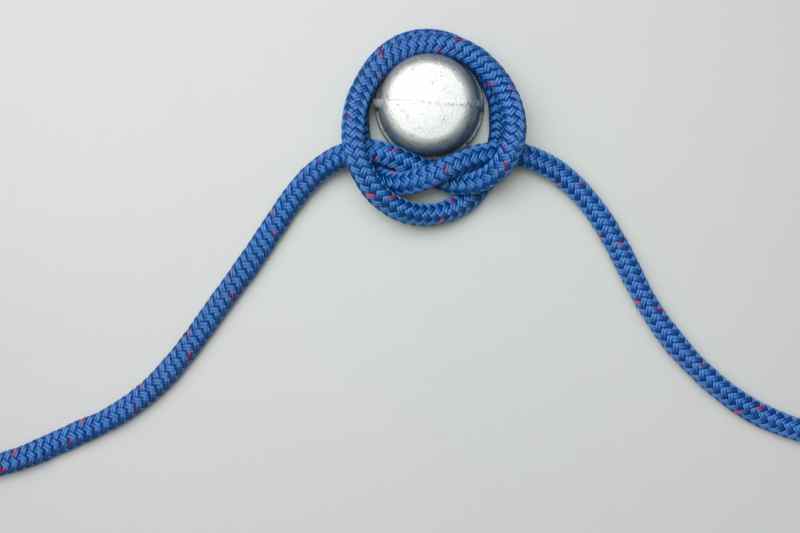Constrictor Knot (Folding Method)
Tie the Constrictor knot using the folding method.
Constrictor Knot (Folding Method)
Tie the Constrictor knot using the folding method.
 |  |

 |  |  |  |  |
To Step use Arrow Keys (
Uses: The Constrictor Knot (ABOK # 1188, p 216.) deserves to be much more widely known and used. It is an excellent quick temporary whipping for a fraying rope’s end and can be used to keep a rope’s end together while it is being whipped. It securely ties the neck of a sack or bag; it has been used as a temporary hose clamp; and it can be used to hold items together for gluing.
Alternatives: In addition to the Folding Method, the Constrictor Knot can be tied by theTwisting Method and byThreading the End when tying this knot round a rail or bar.
Using the Folding Method: The Twisting Method may be ideal for short lengths. However, when a piece of rope is being prepared to act as a binding, e.g., to hold large objects together while glue sets, the length required is too great to form the knot by just “twisting” the rope. The folding method shown here is a better alternative.
Disadvantages: The Constrictor Knot fails when tied against a flat surface – it requires a curved surface for the binding turn to grip the Half Hitch.
Release: The Constrictor Knot can be very hard to undo – cutting the knot can be the only option. When this is necessary, the binding strand should be cut over the other constrictor strands, using them to protect your rope.
Rope Size: The pictures here show the rope tied in large diameter rope. This is only for the photography. The Constrictor Knot is normally tied in twine or other small diameter line.
VIDEO
- Horse & Farm Home
- Bowline Knot
- Carrick Bend Mat
- Clove Hitch – Rope End
- Constrictor – Folding
- Constrictor – Rope End
- Cow Hitch – End Method
- Farmer’s Loop
- Fiador Knot
- Figure 8 Knot
- Halter Hitch
- Honda Knot
- Manger Hitch
- Miller’s Knot
- Ring Hitch
- Rolling Hitch
- Sheet Bend
- Square Knot
- Strangle Knot – Overhand
- Strangle Knot – Using End
- Timber Hitch
- Two Half Hitches
- Horse & Farm Home
- Bowline Knot
- Carrick Bend Mat
- Clove Hitch – Rope End
- Constrictor – Folding
- Constrictor – Rope End
- Cow Hitch – End Method
- Farmer’s Loop
- Fiador Knot
- Figure 8 Knot
- Halter Hitch
- Honda Knot
- Manger Hitch
- Miller’s Knot
- Ring Hitch
- Rolling Hitch
- Sheet Bend
- Square Knot
- Strangle Knot – Overhand
- Strangle Knot – Using End
- Timber Hitch
- Two Half Hitches
- Horse & Farm Home
- Bowline Knot
- Carrick Bend Mat
- Clove Hitch – Rope End
- Constrictor – Folding
- Constrictor – Rope End
- Cow Hitch – End Method
- Farmer’s Loop
- Fiador Knot
- Figure 8 Knot
- Halter Hitch
- Honda Knot
- Manger Hitch
- Miller’s Knot
- Ring Hitch
- Rolling Hitch
- Sheet Bend
- Square Knot
- Strangle Knot – Overhand
- Strangle Knot – Using End
- Timber Hitch
- Two Half Hitches
- Horse & Farm Home
- Bowline Knot
- Carrick Bend Mat
- Clove Hitch – Rope End
- Constrictor – Folding
- Constrictor – Rope End
- Cow Hitch – End Method
- Farmer’s Loop
- Fiador Knot
- Figure 8 Knot
- Halter Hitch
- Honda Knot
- Manger Hitch
- Miller’s Knot
- Ring Hitch
- Rolling Hitch
- Sheet Bend
- Square Knot
- Strangle Knot – Overhand
- Strangle Knot – Using End
- Timber Hitch
- Two Half Hitches





